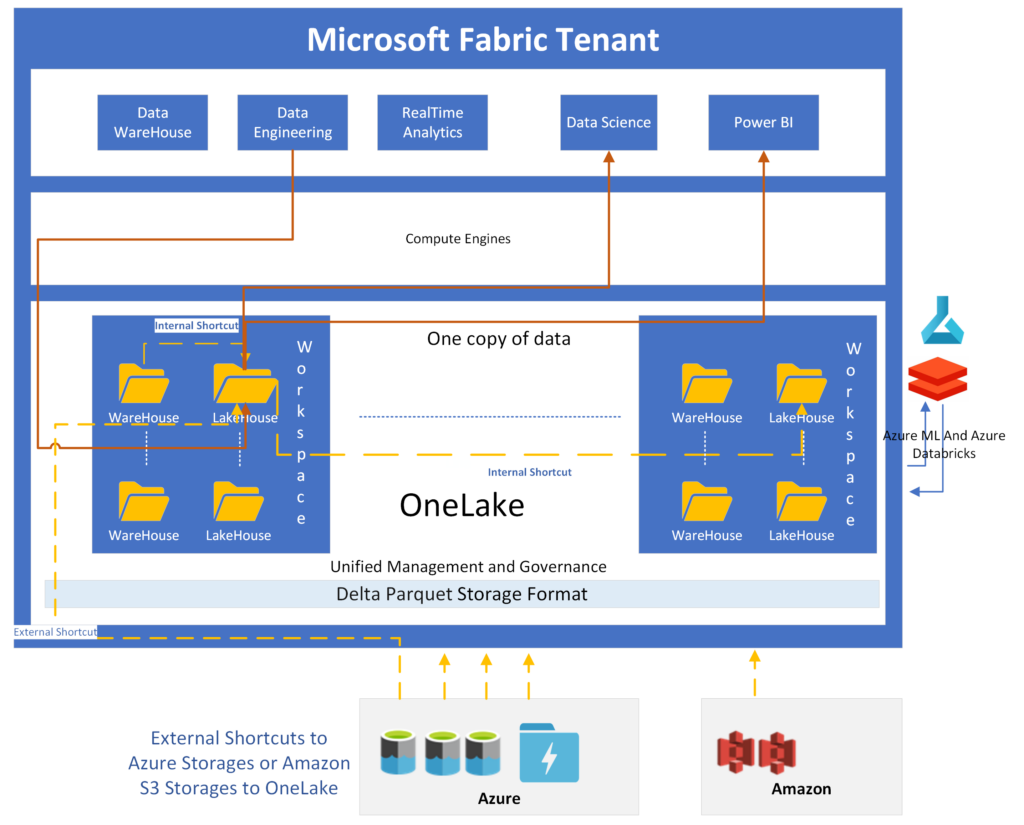In today’s data-driven world, there’s an increasing demand for unified platforms that bring together various tools to work cohesively. In response to this, Microsoft has developed Fabric, a unified platform designed to streamline your business operations by integrating various Microsoft tools into a single, coherent system.
From orchestrating data movement to training machine learning models, harnessing pre-trained AI services like Microsoft Cognitive Services or Open AI Service, defining key metrics, collaborating via Microsoft 365, and providing unified governance, Microsoft Fabric holds the promise of seamless integration and improved efficiencies.
Streamlining Operations with Microsoft Fabric
Microsoft Fabric simplifies data management with a pipeline for orchestrating data movement. This feature provides a streamlined workflow, enhancing data ingestion, processing, and output.
For data scientists and machine learning engineers, Microsoft Fabric offers the capability to train machine learning models. This simplifies the process of creating, training, and deploying models, reducing the time and resources required.
The platform also introduces semantic models for defining key metrics. This level of abstraction enables businesses to fine-tune their KPIs and performance indicators according to their unique requirements.
The platform includes an integrated event streaming no-code workflow for effortlessly streaming data from diverse sources such as Azure IoT hubs, Azure Event Hubs, or your own custom applications, and routing events to multiple destinations like Lakehouse, KQL database, or custom applications.
Single, Unified, Logical Data Lake for the Whole Organization (One Lake)
One Lake is a single organization-wide data lake, effortlessly provisioned for every Fabric tenant without the burden of infrastructure management. Data is stored in the efficient Delta Parquet format. A one data copy serves the multiple analytics engines and OneLake’s Shortcuts, residing within OneLake, directly to various storage locations, whether internal or external such as Amazon S3 storage. You can organize your data and security around the boundary of workspaces, and data access between the workspaces can also be possible using shortcuts.
OneLake offers programmatic access through its API. By simply replacing a OneLake URI, you can easily access your data from OneLake using any API, SDK, or tool that is compatible with ADLS Gen2.
Utilizing the Shortcuts and Open Access features, you can effortlessly create analytics dashboards by unifying data from various sources, including other clouds like Amazon S3, accounts, or within different fabric domains. The below diagram shows the yellow lines of shortcut data and the brown lines show the one copy of data utilizing by Notebooks and Power BI dashboards.

Unified Governance for Secure and Compliant Business Operations
Microsoft Fabric’s unified governance approach emphasizes robust security and compliance measures. It provides information protection using data-sensitive labeling, which helps businesses discover, classify, and protect Fabric data using sensitivity labels from Microsoft Purview Information Protection.
Data loss prevention (DLP) policies are integral to Microsoft Fabric’s approach to data protection. These policies detect and prevent the upload of sensitive data into datasets, offering protection for data such as credit card numbers and social security numbers.
Building Trustworthy Data with Endorsement and Metadata Scanning
To promote quality data within organizations, Microsoft Fabric introduces an endorsement process. This helps elevate high-quality data by labeling them and giving them higher priority in search results.
Metadata scanning is another feature that facilitates improved governance. This helps categorize and track the lineage of source data movement to target applications and helps standardize definitions of data columns, names, types, and any transformations applied.
Microsoft Purview Hub: Centralized Data Management
The Microsoft Purview hub, a centralized page within Microsoft Fabric, helps administrators and data owners manage and govern their data estate. It is a powerful tool that provides complete control over the data landscape.
Data Mesh Architecture Support
Data Mesh is an architectural pattern, this architecture pattern reassigns data responsibilities to individual domains, effectively dismantling data silos. With these responsibilities now residing within domains, it becomes imperative for each domain to have access to a self-service data platform that facilitates the seamless creation of their own data pipelines and data products. Microsoft Fabric, a self-service data platform, is equipped with an embedded data mesh architecture.
Microsoft Fabric makes it easier for various departments (domains) of your organization to create their own data products such as clean data sets, reports and available for use by others. Within Microsoft Fabric, you have the capability to establish logical domains aligned with different departments or functions through the Microsoft Fabric Admin Center. Once each department has established its dedicated domain, it can commence the construction of its data products within specific workspaces, leveraging a variety of Fabric items such as Lakehouse, Warehouse, Notebook, Datasets, Models, and more.
In conclusion, Microsoft Fabric presents a promising platform for businesses looking to consolidate their toolsets and enhance their data management, collaboration, governance, and machine learning capabilities. In an ever-evolving business landscape, a unified platform like Microsoft Fabric can be a game-changer, allowing organizations to operate more efficiently, securely, and smartly. Embrace the future with Microsoft Fabric!
Please don’t hesitate to reach out if you’re considering getting started with Microsoft Fabric and need help with the initial steps or shaping your domains to match the principles of Data Mesh Architecture. We’re here to support you every step of the way.






